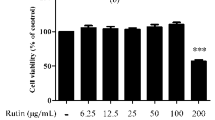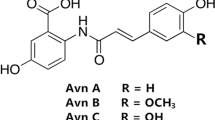Abstract
l-Ascorbic acid (AsA), a reduced vitamin C (VC), is an important antioxidant, and the internal accumulation and maintenance of AsA are thought to play a significant role in various physiological activities in humans. We focused on resveratrol (RSV), a natural polyphenolic compound, as a candidate for an AsA transport modulator and investigated whether RSV can affect the intracellular VC accumulation after either AsA or dehydroascorbic acid (DHA) addition in HaCaT keratinocytes. Our results demonstrate that RSV treatment could significantly enhance intracellular VC levels after either AsA or DHA supplementation, and intracellular VC accumulated mainly as AsA. Our results also indicate that most of the intracellular transported DHA was reduced to AsA and accumulated after uptake into cells. In addition, RSV could induce several AsA or DHA transport-related and intracellular DHA reduction-related genes including SVCT2, GLUT3, TXNRD2, and TXNRD3, necessary for AsA transport, DHA transport, and DHA reduction/regeneration, respectively. On the other hand, the both protein expression levels and the localizations of sodium-dependent vitamin C transporters 2 (SVCT2) and glucose transporter 3(GLUT3) were scarcely affected by RSV treatment. Furthermore, RSV-induced enrichment of intracellular AsA levels was completely suppressed by a GLUT inhibitor cytochalasin B. These results suggest that RSV can potentiate intracellular AsA accumulation via activation of the DHA transport and subsequent intracellular reduction from DHA to AsA. Thus, RSV might be useful for maintaining substantial AsA accumulation in the skin keratinocytes.





Similar content being viewed by others

References
Liang WJ, Johnson D, Jarvis SM (2001) Vitamin C transport systems of mammalian cells. Mol Membr Biol 18:87–95
Rumsey SC, Kwon O, Xu GW, Burant CF, Simpson I, Levine M (1997) Glucose transporter isoforms GLUT1 and GLUT3 transport dehydroascorbic acid. J Biol Chem 272:18982–18989
Wang Y, Russo TA, Kwon O, Chanock S, Rumsey SC, Levine M (1997) Ascorbate recycling in human neutrophils: induction by bacteria. Proc Natl Acad Sci USA 94:13816–13819
Evans RM, Currie L, Campbell A (1982) The distribution of ascorbic acid between various cellular components of blood, in normal individuals, and its relation to the plasma concentration. Br J Nutr 47:473–482
Levine M, Dhariwal KR, Washko PW, Welch RW, Wang Y (1993) Cellular functions of ascorbic acid: a means to determine vitamin C requirements. Asia Pac J Clin Nutr 2(Suppl 1):5–13
Saitoh Y, Nagao N, O'Uchida R, Yamane T, Kageyama K, Muto N, Miwa N (1997) Moderately controlled transport of ascorbate into aortic endothelial cells against slowdown of the cell cycle, decreasing of the concentration or increasing of coexistent glucose as compared with dehydroascorbate. Mol Cell Biochem 173(1–2):43–50
Wilson JX (2005) Regulation of vitamin C transport. Annu Rev Nutr 25:105–125
May JM (2011) The SLC23 family of ascorbate transporters: ensuring that you get and keep your daily dose of vitamin C. Br J Pharmacol 164(7):1793–1801
Sasaki R, Kurokawa T, Kobayasi T, Tero-Kubota S (1983) Influences of sex and age on serum ascorbic acid. Tohoku J Exp Med 140:97–104
Rhie G, Shin MH, Seo JY, Choi WW, Cho KH, Kim KH, Park KC, Eun HC, Chung JH (2001) Aging- and photoaging-dependent changes of enzymic and nonenzymic antioxidants in the epidermis and dermis of human skin in vivo. J Invest Dermatol 117:1212–1217
Hornig B, Arakawa N, Kohler C, Drexler H (1998) Vitamin C improves endothelial function of conduit arteries in patients with chronic heart failure. Circulation 97:363–368
Masaki KH, Losonczy KG, Izmirlian G, Foley DJ, Ross GW, Petrovitch H, Havlik R, White LR (2000) Association of vitamin E and C supplement use with cognitive function and dementia in elderly men. Neurology 54:1265–1272
Yoshida M, Takashima Y, Inoue M, Iwasaki M, Otani T, Sasaki S, Tsugane S, JPHC Study Group (2007) Prospective study showing that dietary vitamin C reduced the risk of age-related cataracts in a middle-aged Japanese population. Eur J Nutr 46:118–124
Aguirre R, May JM (2008) Inflammation in the vascular bed: importance of vitamin C. Pharmacol Ther 119:96–103
Harding AH, Wareham NJ, Bingham SA, Khaw K, Luben R, Welch A, Forouhi NG (2008) Plasma vitamin C level, fruit and vegetable consumption, and the risk of new-onset type 2 diabetes mellitus: the European prospective investigation of cancer–Norfolk prospective study. Arch Intern Med 168:1493–1499
Massip L, Garand C, Paquet ER, Cogger VC, O'Reilly JN, Tworek L, Hatherell A, Taylor CG, Thorin E, Zahradka P, Le Couteur DG, Lebel M (2010) Vitamin C restores healthy aging in a mouse model for Werner syndrome. FASEB J 24:158–172
Saitoh Y, Morishita A, Mito S, Tsujiya T, Miwa N (2013) Senescence-induced increases in intracellular oxidative stress and enhancement of the need for ascorbic acid in human fibroblasts. Mol Cell Biochem 380(1–2):129–141
Saitoh Y, Nakawa A, Tanabe T, Akiyama T (2018) The influence of cellular senescence on intracellular vitamin C transport, accumulation, and function. Mol Cell Biochem 446(1–2):209–219
Harikumar KB, Aggarwal BB (2008) A multitarget agent for age-associated chronic diseases. Cell Cycle 15:1020–1035
Li YR, Li S, Lin CC (2018) Effect of resveratrol and pterostilbene on aging and longevity. BioFactors 44(1):69–82
Malaguarnera L (2019) Influence of resveratrol on the immune response. Nutrients 11(5):E946
Boukamp P, Petrussevska RT, Breitkreutz D, Hornung J, Markham A, Fusenig NE (1988) Normal keratinization in a spontaneously immortalized aneuploid human keratinocyte cell line. J Cell Biol 106:761–771
Savini I, Rossi A, Pierro C, Avigliano L, Catani MV (2008) SVCT1 and SVCT2: key proteins for vitamin C uptake. Amino Acids 34:347–355
Rose RC (1988) Transport of ascorbic acid and other water-soluble vitamins. Biochim Biophys Acta 947:335–366
Okamura M (1979) Uptake of l-ascorbic acid and l-dehydroascorbic acid by human erythrocytes and HeLa cells. J Nutr Sci Vitaminol 25(4):269–279
Dhariwal KR, Hartzell WO, Levine M (1991) Ascorbic acid and dehydroascorbic acid measurements in human plasma and serum. Am J Clin Nutr 54(4):712–716
Cantoni O, Guidarelli A, Fiorani M (2018) Mitochondrial uptake and accumulation of vitamin C: what can we learn from cell culture studies? Antioxid Redox Signal 29(15):1502–1515
Frikke-Schmidt H, Tveden-Nyborg P, Lykkesfeldt J (2016) l-Dehydroascorbic acid can substitute l-ascorbic acid as dietary vitamin C source in guinea pigs. Redox Biol 7:8–13
Park CE, Kim MJ, Lee JH, Min BI, Bae H, Choe W, Kim SS, Ha J (2007) Resveratrol stimulates glucose transport in C2C12 myotubes by activating AMP-activated protein kinase. Exp Mol Med 39(2):222–229
Breen DM, Sanli T, Giacca A, Tsiani E (2008) Stimulation of muscle cell glucose uptake by resveratrol through sirtuins and AMPK. Biochem Biophys Res Commun 374(1):117–122
Deng JY, Hsieh PS, Huang JP, Lu LS, Hung LM (2008) Activation of estrogen receptor is crucial for resveratrol-stimulating muscular glucose uptake via both insulin-dependent and -independent pathways. Diabetes 57(7):1814–1823
Acknowledgements
This work was partly supported by JSPS KAKENHI Grant Number 17K01862.
Author information
Authors and Affiliations
Corresponding author
Ethics declarations
Conflict of interest
The authors declare that they have no conflicts of interest.
Additional information
Publisher's Note
Springer Nature remains neutral with regard to jurisdictional claims in published maps and institutional affiliations.
Rights and permissions
About this article
Cite this article
Saitoh, Y., Umezaki, T., Yonekura, N. et al. Resveratrol potentiates intracellular ascorbic acid enrichment through dehydroascorbic acid transport and/or its intracellular reduction in HaCaT cells. Mol Cell Biochem 467, 57–64 (2020). https://doi.org/10.1007/s11010-020-03700-2
Received:
Accepted:
Published:
Issue Date:
DOI: https://doi.org/10.1007/s11010-020-03700-2



